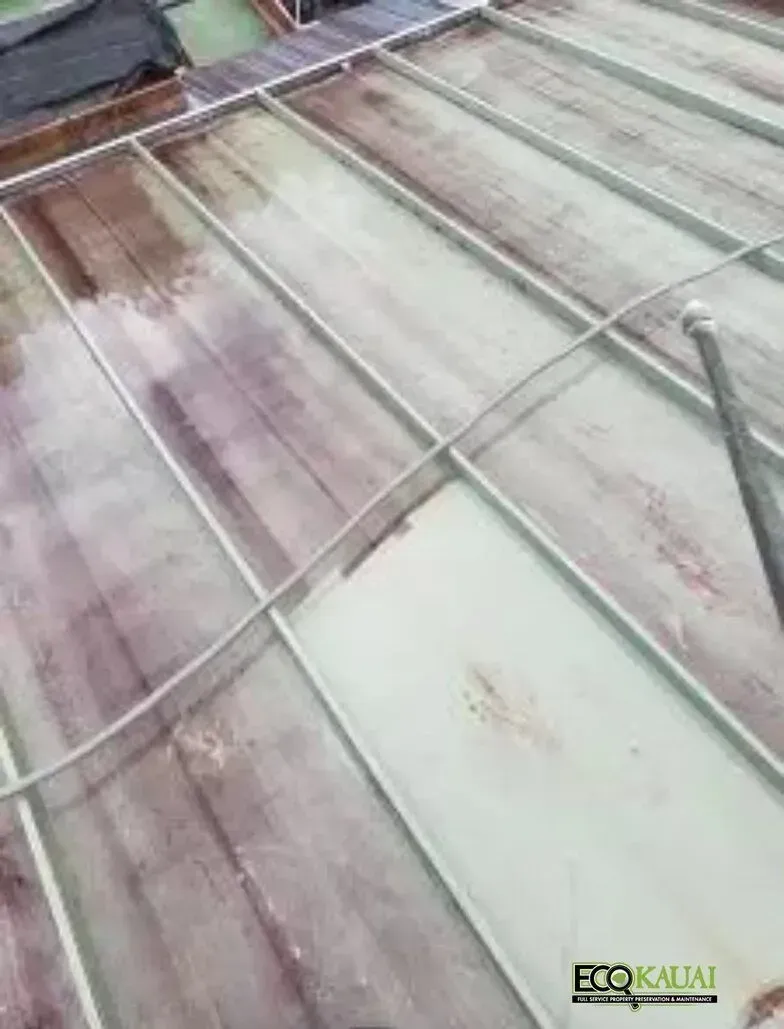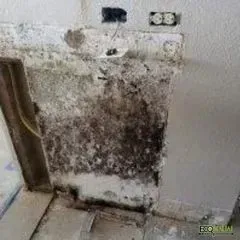Kaua'i, HI Mold Facts
What You Didn't Know About Mold
What is Mold?
Molds are living, eating, reproducing microscopic fungi that live on many different surfaces. They can be found indoors and outdoors and are part of our natural environment. They play an important role in the environment by breaking down and digesting organic materials inside or outside. They are part of the kingdom Fungi.
Molds can multiply by producing microscopic spores similar to the seeds produced by plants. Most spores are so small they easily float through the air and can be carried for long distances by even the gentlest breezes. These spores are so small we can not see them with out a microscope. When mold becomes visible to us that means there are thousands if not hundreds of thousand of mold spores colonized.
There are over a million different species of mold and they come in many different colors. The most common colors include white, brown, orange, green and black. “Black mold” is not a species or specific kind of mold, and neither is “toxic mold.” Sometimes the news media use the terms “toxic mold” and “black mold” to refer to molds that may produce mycotoxins or for a specific mold, Stachybotrys chartarum. Molds that produce mycotoxins are often referred to as toxigenic fungi.
Mold is not usually a problem indoors — unless mold spores land on a wet or damp spot and begin growing. As molds grow they digest whatever they are growing on. Mold growth that is not dealt with can damage buildings and furnishings; molds can rot wood, damage drywall, and eventually cause structural damage to buildings. Mold can cause cosmetic damage, such as stains, to furnishings. Another way to put it is that mold acts kind of like termites. It just takes mold longer to do the same amount of damage as termites.

What does mold need to exist, grow and thrive?
Mold needs water to grow. Without water mold cannot grow. Mold also needs a food source. A food source can be many different things from: clothing, furniture, curtains, drywall, wood, dust, most all porous materials. Mold also needs oxygen and a temperature between 40 degrees and 100 degrees F. Since mold decomposes dead organic material (cellulose, hemi-cellulose and lignin) it can grow on wood, paper (such as on gypsum board drywall) and other materials made from wood. Molds secrete digestive fluids that decompose the substrate, making nutrients available. Mold can also digest some synthetic materials such as adhesives, pastes and paints. While mold cannot get nutrients from inorganic material (non porous) such as concrete, plastic, glass and metal, it can grow on the organic dirt/dust layer on these surfaces. Molds prefer damp or wet material. Some molds can get moisture from the air when the air is very damp, that is when the RH (relative humidity) is typically above 60%. The high humidity makes enough moisture available to make surfaces damp enough for mold to grow.
How Does Mold Spread?
Mold can grow by extension of hyphae that are like tiny root hairs. In this way, a small colony of mold can expand to cover many square feet of material. Mold can also make spores that are like very small seeds. Spores can survive conditions that are too sunny, hot, cold, dry or wet for mold to grow. Many spores can remain dormant for long periods under dry conditions, but typically develop into fungi in the presence of moisture. When spores are released they can be carried by air or water to new locations. Some spores are so small that they are more affected by air currents than by gravity. When spores land on a damp surface that has food and oxygen available, and if the temperature suits them, they will start to grow. It is important to realize that mold spores are ubiquitous in nature and are present everywhere, in outside air as well as indoor air – unless very special precautions are taken to remove or kill them such as in cleanroom and hospital operating theaters. Everyday, since we were born, we have been exposed to airborne mold spores from outdoor sources, sometimes at high concentrations.
Can you get rid of mold completely?
It is almost impossible to create a mold free space or to keep a space mold free. What we can do – and should do – is to control the amount of moisture and hence the amount of mold in our indoor environments.
How can you control mold levels in you home?
We have to remember that mold needs moisture to survive/thrive. If you can control the moisture in your home you can control the mold. There are a few ways to achieve this.
1.) One way is to have the home air conditioned. Keeping the temperature cool and dry. Keep in mind that an air conditioning unit if not kept clean and sanitized can become a great source for mold growth and the spreading of mold spore.

2.) Another way to keep the home dry is Dehumidifiers. Dehumidifiers set bellow 60% RH (relative humidity) will suck access moisture out of the air. Mold can live off of just 60% RH (relative humidity).
3.) Check water sources (under sinks, garbage disposals, toilets, showers, washing machines, refrigerators, dishwashers) in the home routinely to make sure there are no leaks. A small leak can cause a lot of damage. It is also a good practice to check walls that are shared with bathrooms. In a lot of cases these walls are in closets out of sight.
4) A lot of people do “Spring Cleaning” or a deep clean at least once a year. It would be a good Idea to get a antimicrobial cleaning agent to use while you are cleaning.
What are some common misunderstandings/myths about mold?
Bleach kills mold
Bleach does not kill mold on porous surfaces and can actually contribute to mold growth!
If you read the label on your bleach bottle, you will probably see that it is only designated for non-porous surfaces. This means that chlorine bleach can only kill surface mold. Because mold can grow deep roots within porous surfaces, such as wood and drywall, bleach will not assist you in exterminating mold. As the chlorine cannot penetrate to destroy the growth at its roots, therefore, it remains on the surface while the water component of the bleach reaches further, which can actually feed the mold growth. So, if you want to completely eliminate the mold from your home, bleach is definitely not the answer. The worst part is that you may think you have completely eliminated the mold when, in fact, you haven’t.
Bleach is toxic
Chlorine bleach produces fumes that pollute the air and can become harmful to both humans and pets. Chlorine bleach also generates a by-product called dioxin, which is linked to cancer. Used over time, bleach builds up these pollutants in the environment. As we’re sure you’ll agree, the last thing you want to do is create more toxic chemicals in your home – mold is toxic enough! There are many safer alternatives which are also much more effective at getting rid of mold.

“Black mold” is the only dangerous mold
The truth is there really is black mold – over 20,000 species in fact. However, Stachybotrys, the “toxic black mold” of most concern, is not always toxic. The truth is, none of the million-plus mold species are always toxic. The only two things you know for sure when you see “black mold” is you have mold and that it is black in color. That’s all unless you do lab tests to identify. Scientifically, there is no mold genera or species that is called “black mold” or “toxic black mold.” Of the million-plus species of mold, about 20,000 species are indeed black. Most species appear green, brown, orange, white, or even pink. Stachybotrys, a common type of mold thought to be the most toxic, is actually a greenish-black in color but can be white or a slight pink color depending on the environment it is growing in and the food it “eats.” Mold of any color can be “toxic” under the right conditions, so using color as a red flag is a bad idea.
You can get rid of mold completely,
There is no such thing as a mold-free or mold-proof home. Mold spores are part of the natural environment, and are all around us both when we are inside and outside. Mold spores exist in the air inside our homes, but we can cohabit peacefully as long as those spores don’t find moisture and start growing. . Mold is only an issue when its concentration reaches unhealthy levels, typically (but not always) as large, visible colonies. It would be virtually impossible (and totally unnecessary for most people) to remove every last mold spore from your home.
What are the most common species of mold found in you homes?
Cladosporium
Cladosporium is the most common mold found in air samples from both indoor and outdoor environments. Like Alternaria, it thrives on vegetation and wood and is also a prime culprit in regards to allergies.
Physical Characteristics: Cladosporium mold is dark (green, brown, or black) with a velvety texture.
Health Symptoms: Sneezing, headaches, itchy and watery eyes, runny nose, congestion, coughing and rashes.
Penicillium
Penicillium is a common both indoors and outdoors. Outdoors it can be found growing in soil, decaying plant debris, and fruit rot. Indoors it can be found growing on water damaged building materials as well as on food items. Some toxigenic species cause infections while others produce antibiotics and MVOC gasses.
Physical Characteristics: Penicillium mold is mostly green, blue-green, or grey-green, but can be white, yellow, or pinkish. Its texture ranges from mostly velvety to powdery.
Health Symptoms: Headaches, itchy and watery eyes, runny nose, congestion, coughing, sneezing and rashes. Asthmatic symptoms
Aspergillus
Aspergillus is a very common indoor mold as it includes a few hundred species, which can grow in a variety of places including walls, ceilings, crawlspaces, sub flooring, and more. Its spores are generally dispersed through the air and target those individuals with compromised immune systems. Some species can give off harmful mycotoxins, MVOC (microbial volatile organic compound) gasses, and other potentially harmful byproducts.
Physical Characteristics: Aspergillus mold is often green, but can range in color from white to brown or black.
Health Symptoms: Headaches, trouble sleeping, itching, rashes, fatigue, sneezing and coughing. Asthmatic symptoms
Aspergillus can grow in human tissue. People with weakened immune systems are susceptible to this growth, which can be fatal.
Alternaria
Alternaria is one of the most common outdoor molds that thrives on vegetation and wood. However, it can also be found in the indoor environment and can be transported through the air or on the skins of fruits & vegetables. Alternaria is a prime culprit when it comes to allergic reactions.
Physical Characteristics: Alternaria mold is dark (grey, brown, black) with a velvety texture.
Health Symptoms: Development and/or agitation of Asthma, Sneezing, itchy and watery eyes, runny nose, congestion, coughing and dry skin.
What are some symptoms of mold exposure and who are at greater risk of exposure?
The most common symptoms of mold exposure are nasal and sinus congestion, eye irritation, blurred vision, sore throat, chronic cough, skin rash, allergies and asthma.
Children that have not built up a strong immune systems yet and elderly people that have a week immune system are at higher risk of being affected by the mold. That is not to say a young healthy individual can not be affected by mold. Each individual is different.

